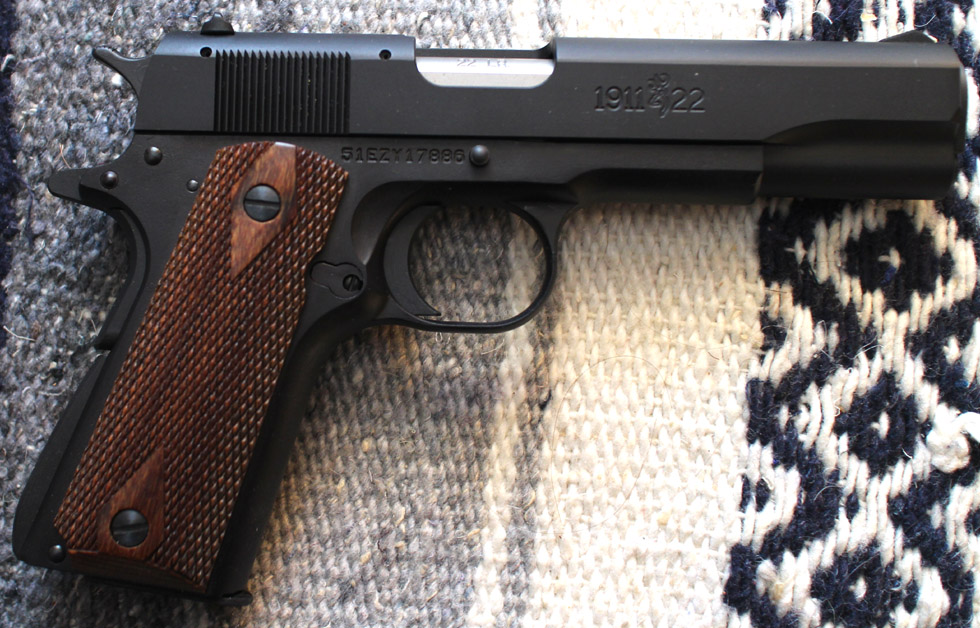
Browning 1911-22
| Dimensions | Barrel Length | Weight | Caliber | Action Type | Magazine Capacity |
| 7.5" |
4.25" |
15 oz |
.22 LR |
Semi |
10 |
When I first saw one of these, a few years back, I had to have it. A look at the photos gives a pretty good idea of why. The gun is wonderfully made and finished. It is also a faithful replica of its sire. Now this may sound a little strange, as there are perhaps hundreds of 1911 clones and knock offs in many different calibers, including the 22 caliber ace, and similar models. What makes this gun unique is its size. Looking at these photos it may appear this is a full sized 1911, but it is not. The 1911-22 is rendered at approximately 85% full size. It is like shooting a scaled down model, in a scaled down caliber.
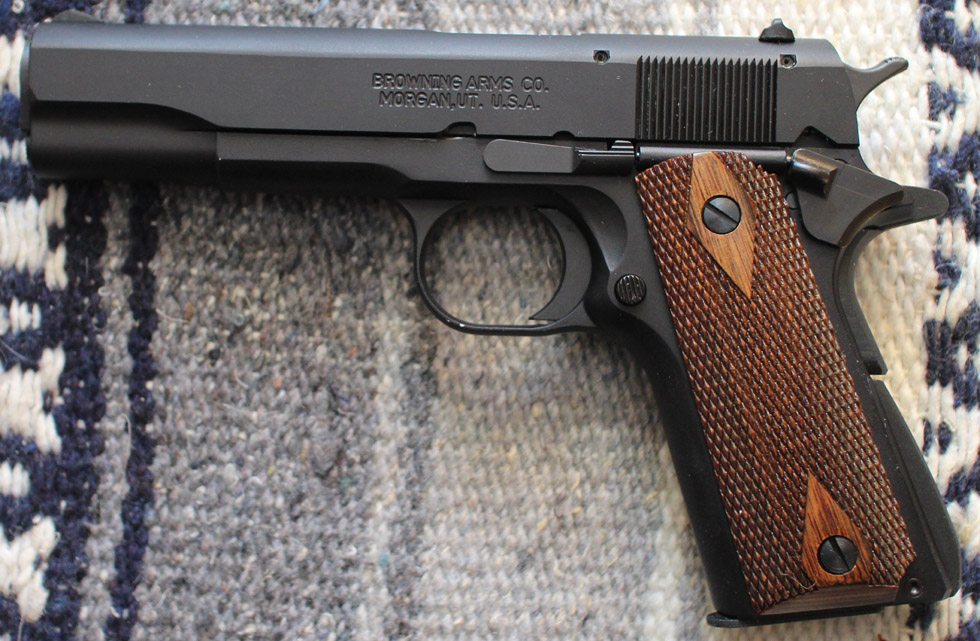
For cheap practice, gaining familiarity, ease of shooting, or just plain fun, the gun is hard to beat. For young people, or for those with somewhat smaller hands, this may be the ideal sized pistol. The operation is the same, with all of the same controls in the same locations, including the magazine release, safety, grip safety, and slide release. All the same - only smaller. A picture of the gun in my averaged sized hand might give a better idea of its size.
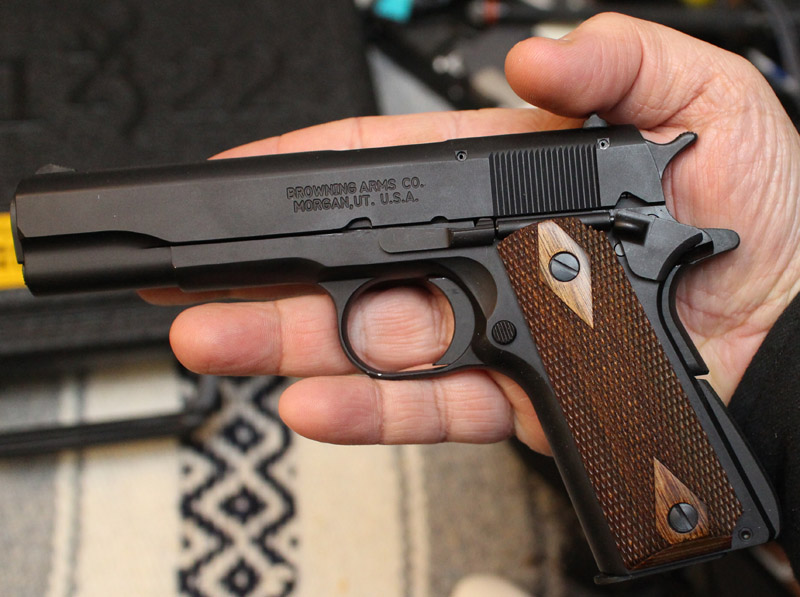
I may have overstated the deficiencies of this gun a bit. The 1911-22 is small, light, fairly easy to conceal, is very dependable, and very well made. It is quite a bit of fun to shoot, and can shoot into less than two inches at normal ranges. The trigger is decent, and the sights, though terrible, are no worse than those on the original. In short, the little gun reflects all of the good and bad qualities of the gun from which it was descended. Sadly, it also pretty closely reflects its cost.
The Browning 1911-22 sells for around $600, with some versions costing a bit more, and others a bit less. I rarely see them discounted. This is very expensive for a 22 semi, and is double the cost of Browning's excellent full sized Buck Mark pistol in the same caliber. For $600 a number of full sized 1911 models are available in full powered calibers like 9mm and 45.
Cost was what prevented me from buying one of these little gems, for a number of years. What put one in my hands was when Gander Mountain went out of business. For weeks, they marked their firearms down, just a little at a time. Finally, the last week before they closed, they made their final markdowns. I was able to acquire a 1911-22 for less than $400. Ironically, it was sitting in the case next to a Remington full sized 1911 in 45 caliber - for the same price. I already have a half dozen 45 autos, or the decision would have been a hard one. As it was, I grabbed the little 1911-22 and never looked back.
So what do you get for your $600? The little gun is manufactured of aluminum alloy, with diamond checkered wood grips. Some earlier models had plastic grips. Aluminum is impervious to rust, which is nice, though it is softer than steel, and I worry that the slide stop and some of the other steel parts may wear away at the frame and slide over time. The finish has the look of a military parkerized finish. The light weight of the aluminum frame (less than a pound) adds to the idea that this is a miniature or model gun. It feels for all the world like you are holding a little air pistol.
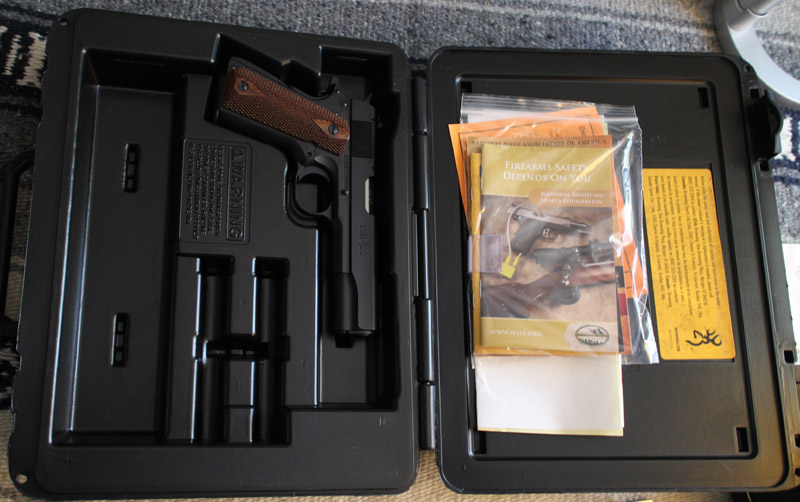
This little gem of a gun comes in a full sized molded case. The case has compartments for the gun, a pair of extra magazines (not included), a large compartment which could hold ammunition (in the places where such things are allowed to be stored together), and the usual tab on the lid for holding manuals and paperwork. Also included was a cable lock.
I do plan to get a pair of extra magazines for this gun. They are not cheap. Retail is around $45 each, with real world prices of $30 - $35. I am also considering a new rear sight to replace the very small stock rear sight. I am presently using the holster from my PPK, which is very similar in size, but am hoping for something that gives a more exact fit.
Shooting this little beast is a joy. Recoil is almost unnoticeable, and the grip angle of 18 degrees off square is the same as that of the full sized 1911, as is the curved backstrap, which makes this a natural pointer for anyone who shoots a full sized 1911. I refuse, for the moment, to get into the old grip
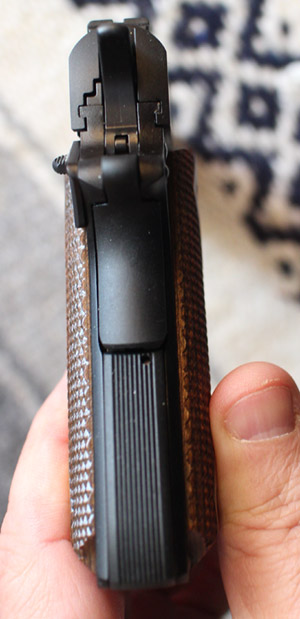 angle argument, except for the
following general concept. If all of our fingers were the
same size (which they are not), and all curled the same way
(which they don't), then the ideal grip angle would be 90
degrees (which it isn't). With things the way they are, a 90
degree angle will not make a gun a very good natural
pointer. Everyone agrees on this. The argument is over just
what the ideal angle might be. The Glock has a 22 degree off
center, and the old Luger P-08 had a 54 degree off center.
Other guns may have different grip angles. To me, it seems
the ideal grip angle is that at which a given user has the
most practice.
angle argument, except for the
following general concept. If all of our fingers were the
same size (which they are not), and all curled the same way
(which they don't), then the ideal grip angle would be 90
degrees (which it isn't). With things the way they are, a 90
degree angle will not make a gun a very good natural
pointer. Everyone agrees on this. The argument is over just
what the ideal angle might be. The Glock has a 22 degree off
center, and the old Luger P-08 had a 54 degree off center.
Other guns may have different grip angles. To me, it seems
the ideal grip angle is that at which a given user has the
most practice. At any rate, between the grip angle and shape, the lack of recoil, the single action trigger pull, and
the inherent accuracy, I can shoot into less than two inches with no problem. I can also rapid fire this gun, which is not something I can do with a 1911 in 45. I have so far (in about 200 rounds) had no failures, stoppages, or other issues with the gun.
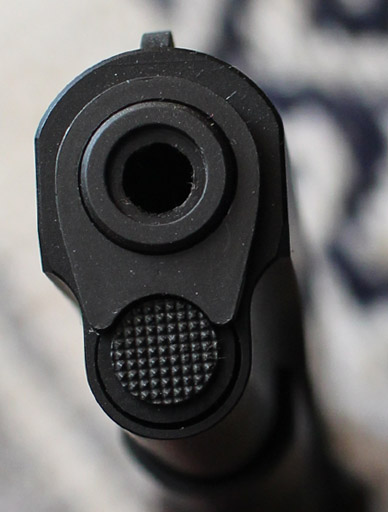 One big difference is that a day at the range with the
1911-22 costs around $5 to $10 in ammunition, as opposed to
the $25 to $50 of a day with its big brother. This is also a
far easier gun to shoot. Of course, you can't reload for 22,
nor is it anywhere near the man-stopper of the 45. That
little hole in the front makes a big difference.
One big difference is that a day at the range with the
1911-22 costs around $5 to $10 in ammunition, as opposed to
the $25 to $50 of a day with its big brother. This is also a
far easier gun to shoot. Of course, you can't reload for 22,
nor is it anywhere near the man-stopper of the 45. That
little hole in the front makes a big difference. Of course, nothing is without flaws. Even the full sized 1911 has its detractors, and its weaknesses. In common with the full sized 1911, the 1911-22 has marginal sights. You can get used to them, through training and practice, but that's the point - they take some getting used to. I am considering replacing the rear sight in this gun, but after market selection is limited.
The other issue with this gun is a less than perfect trigger. Not, the trigger is pretty good, light, and fairly crisp, but this particular example has a fair amount of slack before engagement. I am hoping that after the break in this clears up, but usually creep is more a matter of trigger bow adjustment, and a slight bit is necessary for proper function of the gun. It is also a very small thing, so perhaps I will just get used to it.
Where this gun may find its ideal niche is in the newly created demand for civilian CCW weapons. It is, in many ways, ideally suited to such a role. A full sized 1911 is not an easy gun to conceal. the 1911-22 is smaller in every dimension, and is particularly thin. At the slide, the gun is less than three quarters of an inch thick. Even at its widest point, around the grips, it is just over an inch, and it is possible to get shaved grips for concealment. A 22 is also a very easy gun to shoot, for casual CCW of someone who is not particularly a gun enthusiast. Now there are lots of little 22 pistols out there, but none of them fire and handle like a 1911, nor do most embody the quality of the Browning.
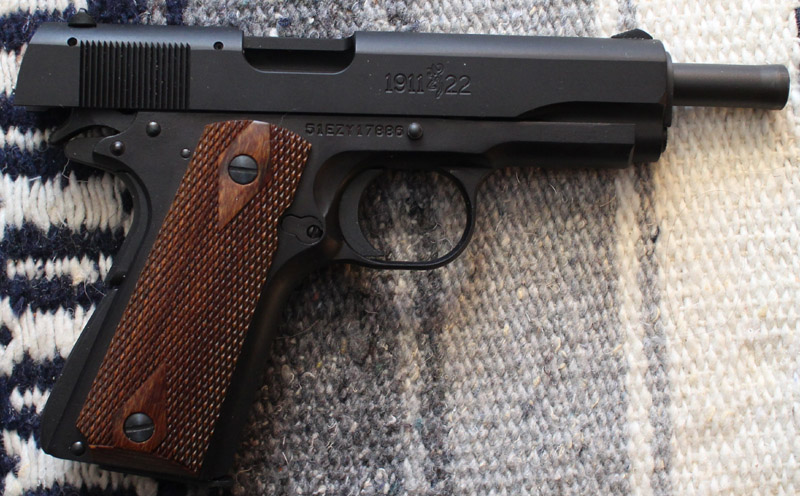
Please note that when the slide is locked back, the barrel tilts, and goes out of engagement with the slide - just like a big 45. Though this is a pure blow-back, non-locking action, it emulates perfectly the action of the classic 1911. Also note the belled muzzle end of the barrel, to tighten it up with the barrel bushing.
This is one of those guns that gets a lot of second glances at the range. For a really fun day, I can take my 1911-22, and my tiny AA Mini Revolver to my practice sessions. People stare, they smile, they ask what this is and how it shoots. They then ask how much it costs, and shake their heads sadly after I tell them. This gun practically begs for an old style leather holster and leather magazine pouch scaled to size. It presently is carried in an Uncle Mike's Super Belt Slide holster, size 1. It fits well enough, but the little barrel sticks out a bit. There is a commander version of the 1911-22 made, and I suspect that this model would fit this holster perfectly. Browning makes a number of different holsters, which it sells at Browning prices. The Uncle Mike's will do for now, and as thin as the gun is, makes for a great concealed carry combo.
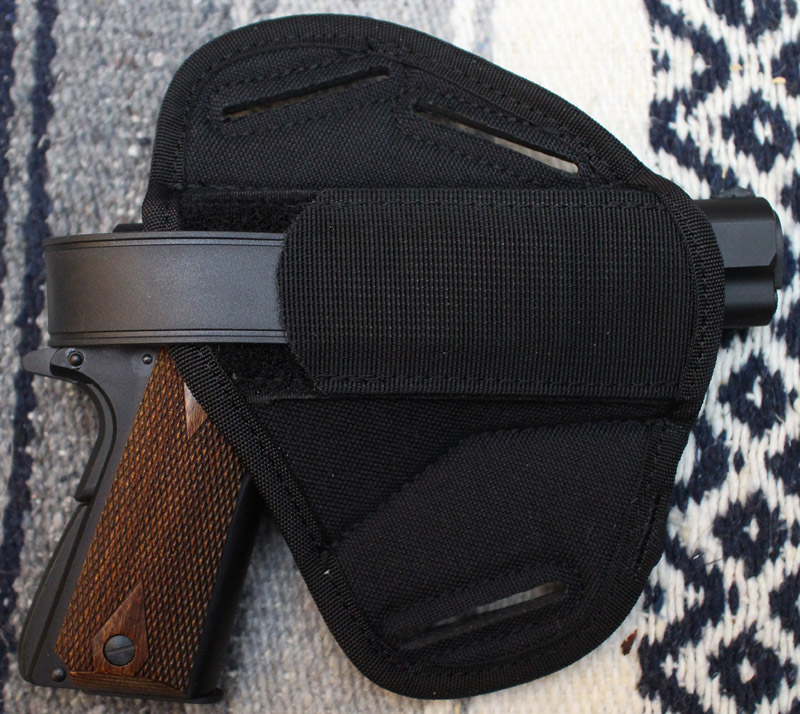 Though I usually prefer a stainless revolver as my carry
gun, the rust impervious aluminum frame, along with the thin
profile and general small size practically beg to have this
as a CCW piece, despite the pipsqueak caliber. At any rate,
a CCW gun is one of those things that you hope never to have
to use, so caliber may not matter too much. There is the old
saying that the 22 you have with you is better than the 45
you left at home.
Though I usually prefer a stainless revolver as my carry
gun, the rust impervious aluminum frame, along with the thin
profile and general small size practically beg to have this
as a CCW piece, despite the pipsqueak caliber. At any rate,
a CCW gun is one of those things that you hope never to have
to use, so caliber may not matter too much. There is the old
saying that the 22 you have with you is better than the 45
you left at home. It works as a novelty gun, a CCW gun, a plinker, cheap shooter, and a practice gun for its big brother full sized 1911 45 ACP. It also makes you smile every time you pick it up - the kid brother to my old ugly 1911 in 45. It works on so many levels, that you can see why I had to have one. Admit it; now you have to have one too.
The gun field strips exactly like the old classic 1911, as is shown in the pictorial below:
| Field stripping and cleaning |
|
| Remove the magazine. After magazine removal, take off the safety and pull the slide back several times to clear any rounds. This is the most important step. failure to do this may result in death or injury. |
|
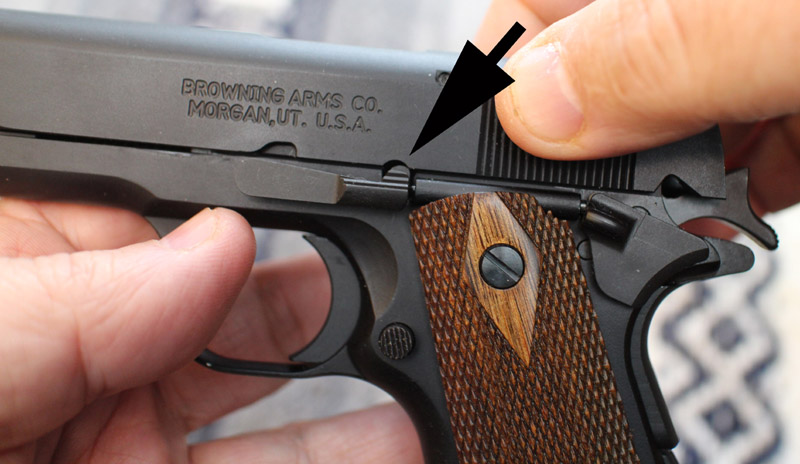 |
On the left side of the slide, line
up the take down notch with the end of the slide
stop. |
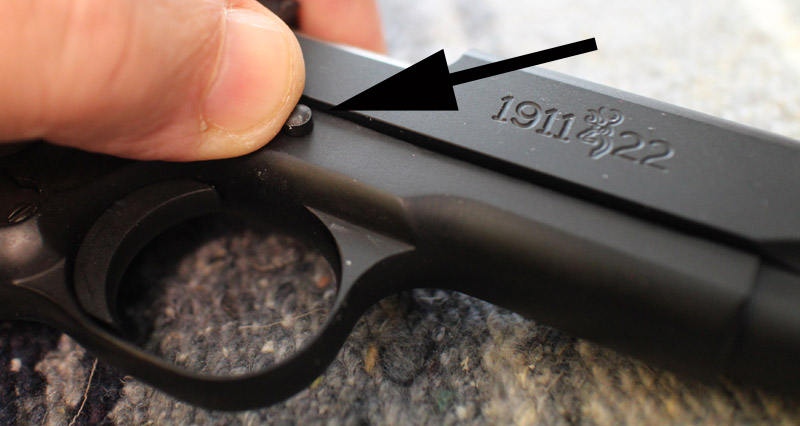 |
Once the slide is properly lined up,
on the right hand side of the slide, simply push the
slide stop out to the left. |
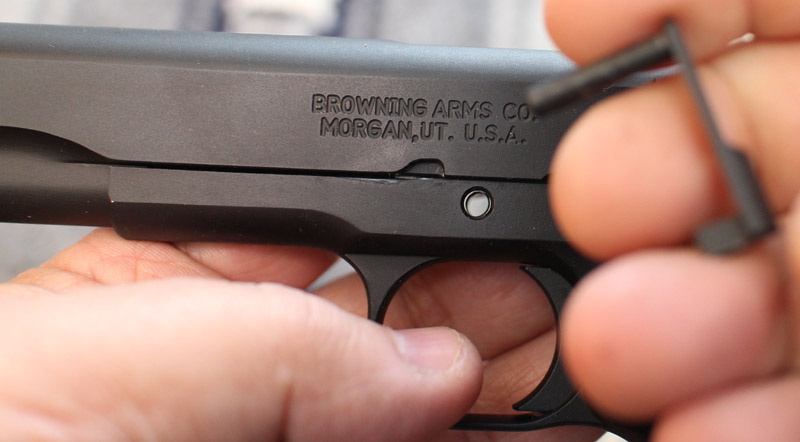 |
Remove slide stop. |
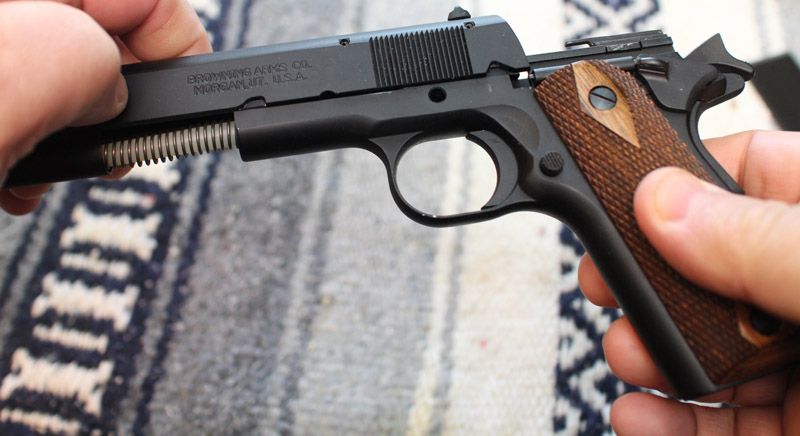 |
The slide may now be pulled off of
the frame. |
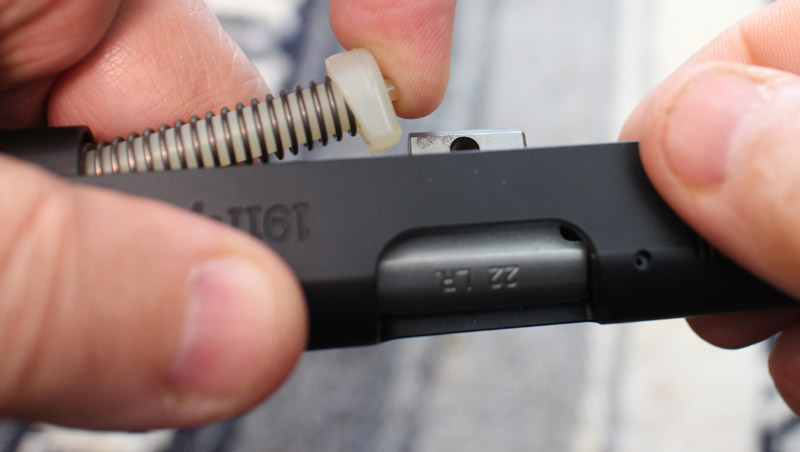 |
Depress the spring guide rod, pull
up, and then remove guide rod and spring from
beneath the barrel. |
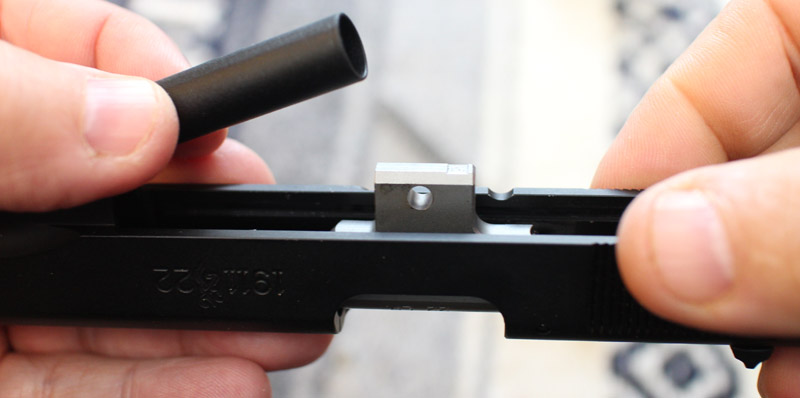 |
Remove the follower. You may be able
to do this at the same time you remove the spring
and guide rod, but I have found that it usually
easier to pull the spring from the follower, and
then remove the follower separately. |
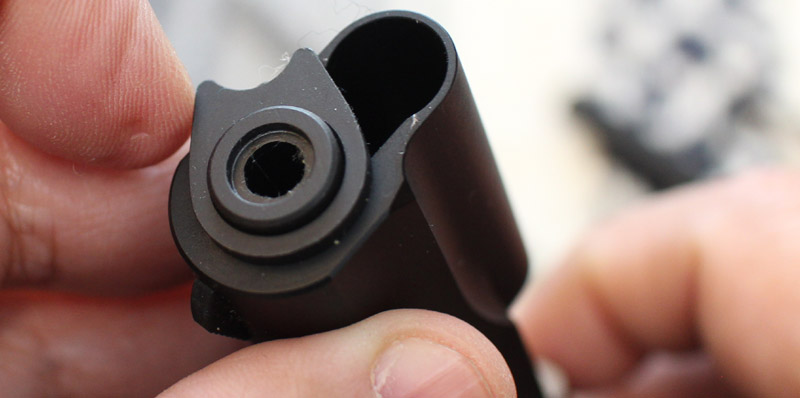 |
Turn the barrel bushing counter
clockwise, and pull forward to remove. |
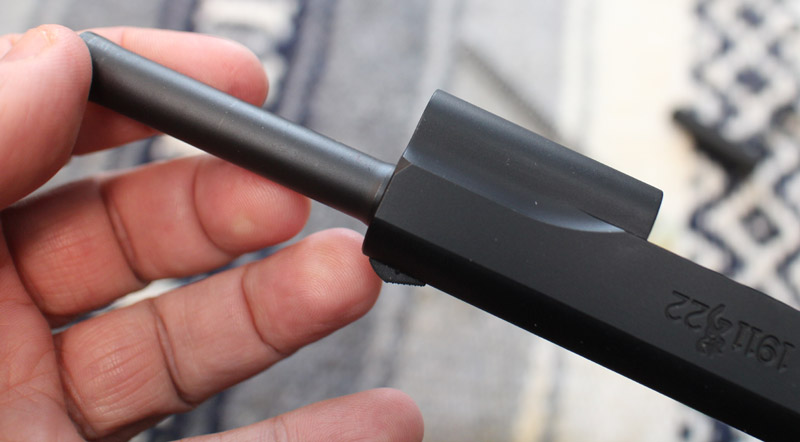 |
remove the barrel by simply pulling
it forward and out of the slide. |
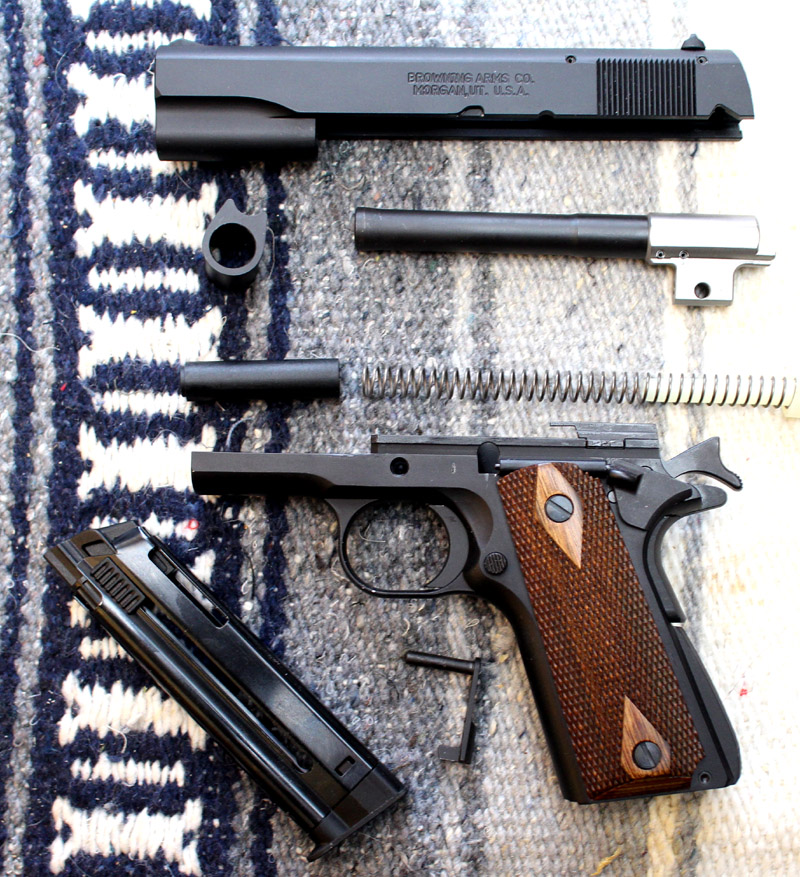 |
The gun is now field stripped and ready to clean. |